Animal Crossing: New Horizons is having a bit of a moment. For those of you who don’t know, Animal Crossing is a game about collecting bugs for a terrified owl, fishing for a rare fish that just won’t spawn, low-key flexing on your friends, and about once a week, meticulously analyzing famous artworks so you don’t get hoodwinked by a fox who definitely does not have your best interests at heart.
It’s ostensibly a game about nothing. There’s no goal, other than paying off your interest-free house loan to an increasingly rotund tanuki. Since vast swathes of the world’s population have been isolated for the past few months, people have found increasingly creative ways to connect with each other through the game. (Not me; I’ve just been terraforming my island for hours on end, only to regret it the next day.)
Unlike me, Sienna Stevens, an associate in the Museum Store, has spent the past few weeks painstakingly recreating art from the Crocker's collection for an in-game gallery. (Watch out Blathers; Sienna is coming for you.) And she did it during finals, no less! Sienna writes:
"I must admit, during the stay-at-home order, I've done what many other people are doing and hopped on the Animal Crossing bandwagon. I have missed my Crocker family and the beautiful art so much that I've started to assemble items in the game and recreate a gallery with some highlights from our collection in my virtual house. It's been really therapeutic and a nice little escape from reality."
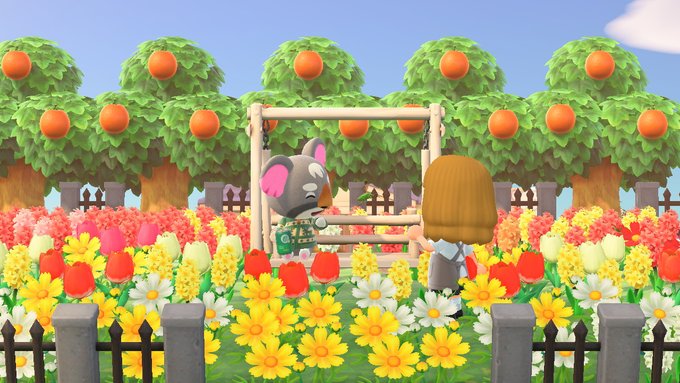
Animal Crossing is also a game about hanging out with ridiculously cute animals, like Gonzo, a cranky koala who loves nature. Screenshot: Nintendo (Sienna Stevens).
Sienna's recreations are too good not to share. So, without further ado, here are some of her favorite works of art from the Crocker, recreated for Animal Crossing: New Horizons, along with information about their real-life counterparts. If you’d like to put these works in your own world, contact Sienna on Instagram, @peach.momm. (At the time of writing, her Content Creator Code is not working.) And, if you're playing Animal Crossing, keep an eye for similar content from other institutions. We're not the first organization to jump on the Animal Crossing bandwagon.
Music, Love, and Allegory
[From left to right] Edwin Howland Blashfield (American, 1848–1936), Music, ca. 1890s. Oil on canvas, 28 x 15 in., Crocker Art Museum, gift of the Ladies Museum Association, 1939.61.2.
Charles Christian Nahl (American, born Germany, 1818–1878), The Love Chase, 1869. Oil on canvas, 62 x 88 in. Crocker Art Museum, E. B. Crocker Collection, 1872.379.
Screenshot: Nintendo (Sienna Stevens).
At the entrance of Sienna's gallery is a painting of a woman by Edwin Howland Blashfield (1848–1936). Between 1880 and 1914, many Americans believed that art and architecture could serve as moral inspiration and continued Greek, Roman, and Renaissance ideals. Blashfield, one of the artists most closely associated with this “American Renaissance", decorated numerous state and federal buildings with murals and supplied paintings for the mansions of New York’s elite. His lectures and 1913 book, Mural Painting in America, were integral to the era's revival of mural decoration. Blashfield ultimately became president of the Society of Mural Painters and of the Society of American Artists.
The easel paintings that Blashfield produced often related to his mural work. However, they also included costumed genre scenes, portraits, views of antiquity, and allegorical subjects in architectural settings. In this painting — Music, circa 1890s — music is personified by a woman wearing a Greek chiton and draped in rich, red fabric. The frieze-like format enhances the overall sense of antiquity and makes the figure appear as part of a larger architectural scheme.
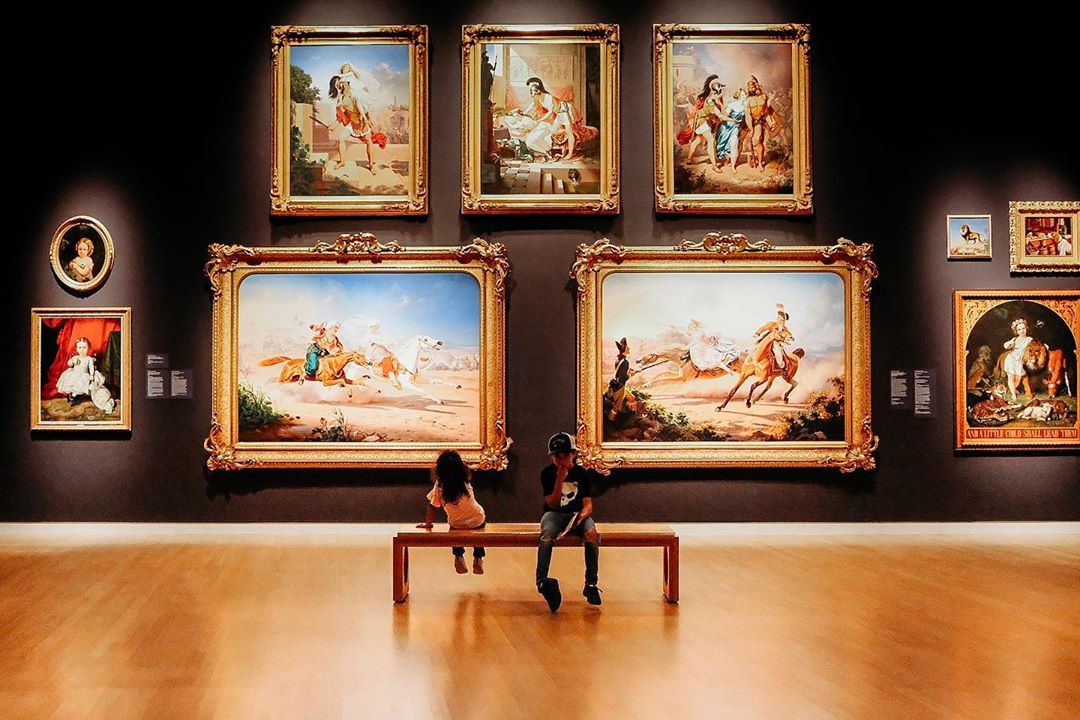
Love Chase, 1869 (left), on display at the Crocker. Photo by @justjacky.
The other work — also pictured above in the Crocker's galleries — is arguably one of the Crocker’s most photographed works. Love Chase (1869) was created by Charles Christian Nahl, a German immigrant who became a prolific painter and lithographer of the California Gold Rush. Nahl (1818-1878) enjoyed the patronage of prominent citizens in San Francisco and Sacramento for his portraits and genre scenes.
Many of Nahl's best-remembered scenes were painted in the final decade of his life. Five monumental works were commissioned by the Museum's founders in the late 1860s and early 1870s, including Love Chase. The massive oil painting depicts a young man wooing the daughter of a Sheik. According to custom, the Sheik provided his best horse to his daughter and a lesser horse to her suitor, who then raced to catch her. If the girl was favorably disposed, as is the case here, she would rein in her horse and allow herself to be caught.
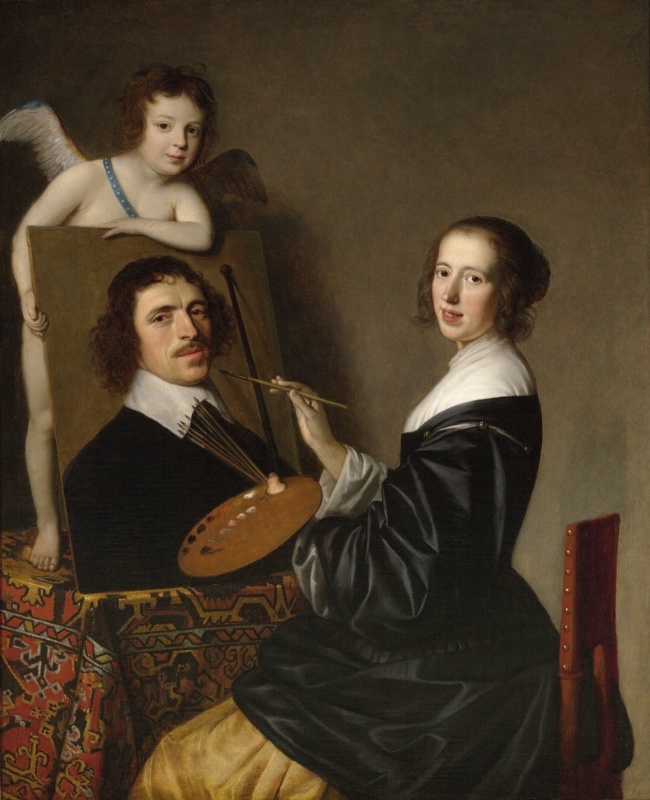
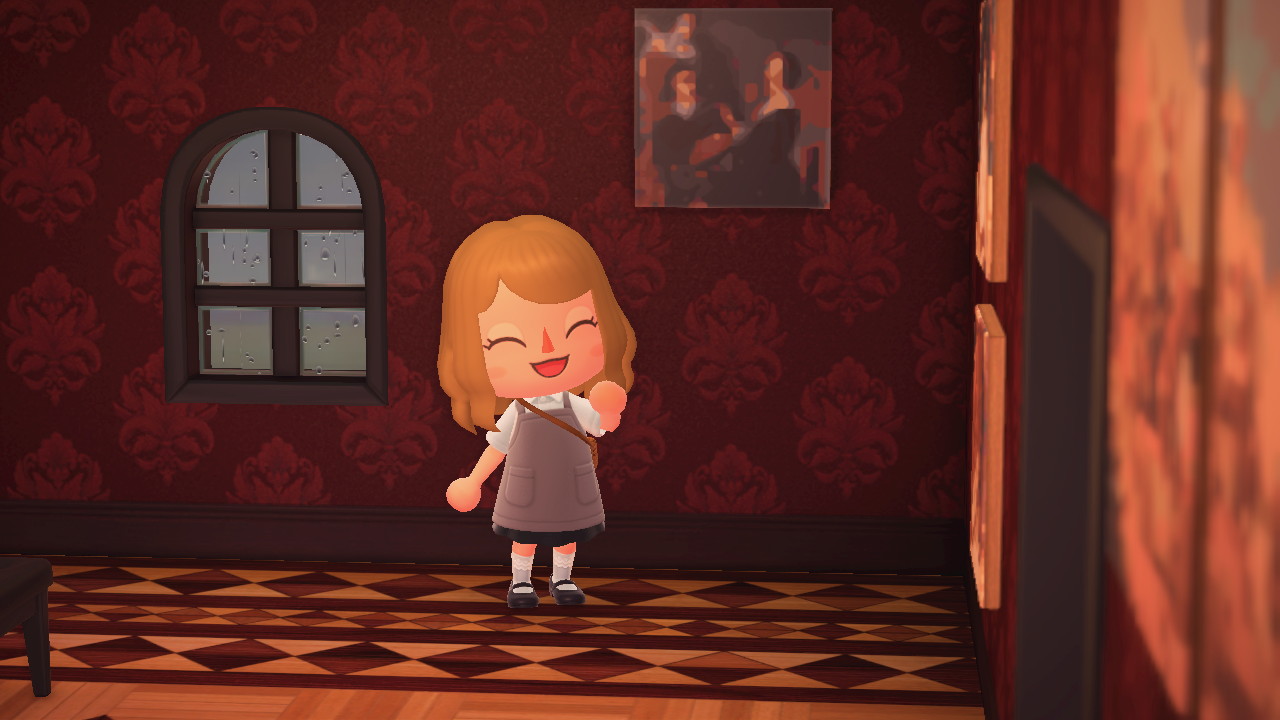
Gerrit van Honthorst (Dutch, 1590–1656), Allegory of Painting, 1648. Oil on canvas, 54 5/16 x 44 1/2 in. Crocker Art Museum, gift of Suzanne Nady in memory of her parents, Jeanne and Joseph Falk, 1998.10.
Screenshot: Nintendo (Sienna Stevens).
To the left of Blashfield's Music is arguably one of the Crocker’s most "memeable" paintings: Allegory of Painting. Created by the noted Golden Age Dutch artist Gerrit van Honthorst in 1648, the work combines allegory and portraiture. The female sitter uses the tools of the trade — brushes, palette, and mahlstick — to finish a fictive portrait. Although she is represented as Pictura, the personification of painting, she is also a specific woman, perhaps a studio model. Cupid likewise balances allegory and the human realm. The depicted work-in-progress is thought to be Honthorst’s self-portrait.
Van Honthorst began his artistic training with his father, a decorative painter living in Utrecht, before becoming an apprentice to the Mannerist painter Abraham Bloemaert. Honthorst eventually traveled to Italy, an experience that profoundly transformed his style. By 1616, he was living in Rome in the house of financier and collector Vincenzo Giustiniani. The financier's collection — which included ancient sculpture, as well as paintings — was rich in the works of Caravaggio, who had died only six years before. The famed Italian artist’s use of contrasting light and dark inspired Honthorst to concentrate on similar scenes, earning him the nickname Gherardo delle Notti or Gerrit of the Night Scenes.
A Mural and a Potrait
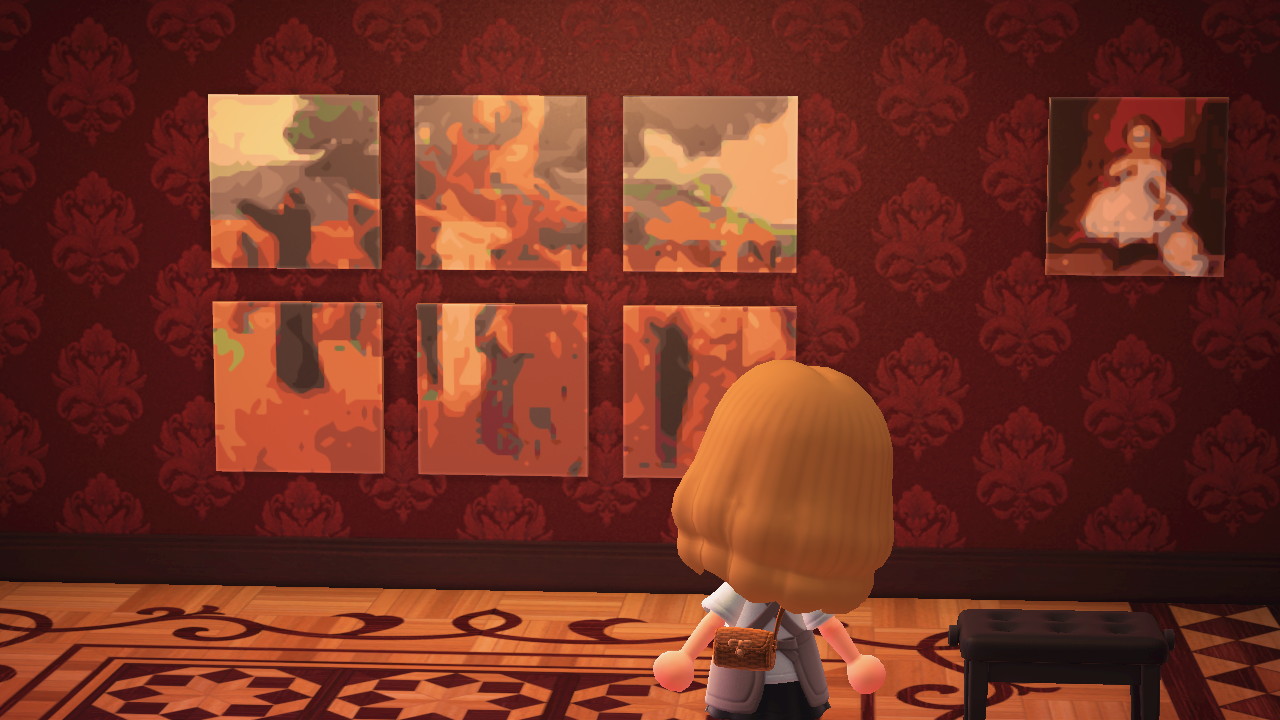
[From left to right] Arthur Mathews (American, 1860–1945), Vision of Saint Francis, 1911. Oil on canvas, 91 1/2 x 161 1/2 in. Crocker Art Museum, gift of American Trust Company, Sacramento, 1950.29.
Charles Christian Nahl (American, born Germany, 1818–1878), Little Miss San Francisco, 1853. Oil on canvas, 38 x 30 in. Crocker Art Museum purchase, with funds from Mrs. T. Warren Kyddson in memory of her husband, Dr. T. Warren Kyddson; Mr. and Mrs. Vern C. Jones; Crocker Art Museum Memorial Funds; and others, 1986.3.
Screenshot: Nintendo (Sienna Stevens).
On an adjacent wall are two works by California artists: Vision of Saint Francis (1911) by Arthur Mathews and Little Miss San Francisco (1853) by Charles Christian Nahl.
The nearly 14-foot mural by Mathews captures all of his preferred subjects at once: allegories, antiquity, and local history. The primary subject is St. Francis, here dressed in the robes of a Franciscan padre and gazing toward what would one day become San Francisco. The painted border of fruit and foliage, in emulation of a frame, was likely painted by Lucia, who, along with Mathews, is credited with creating the California Decorative style, which combined elements of European Art Nouveau and classical antiquity with California trees, flowers, and locales.
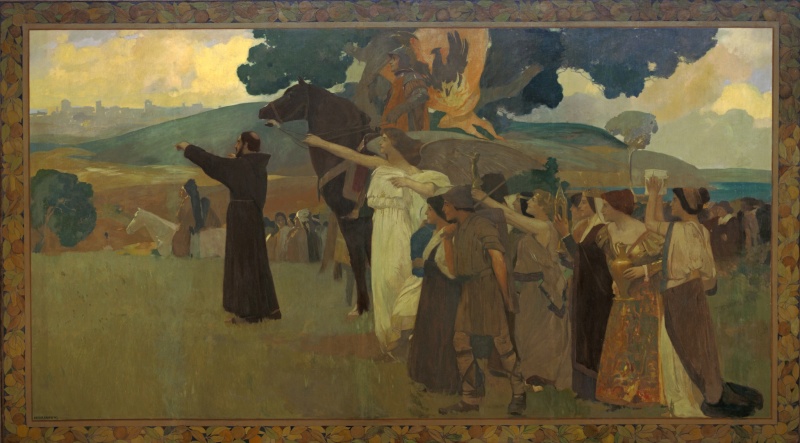
Vision of Saint Francis, 1911.
Originally commissioned by the Savings Union Bank in San Francisco in 1911, the monumental work drew “great crowds of spectators” to Mathews’s studio. A San Francisco reviewer described the accomplishment:
“The painting, ‘Saint Francis,’ would seem to be an artistic interpretation of, 'Westward, the course of empire takes its march.' In the foreground appears the great concourse of the ages; here a puritan of simple habiliments, there a courtier of a gone by day, here an Indian aborigine, there a knight in quest of glory, while leading them all is the brown clad figure of the great Saint, his arms uplifted toward the distant goal, the promised, 'city beautiful'" (1).
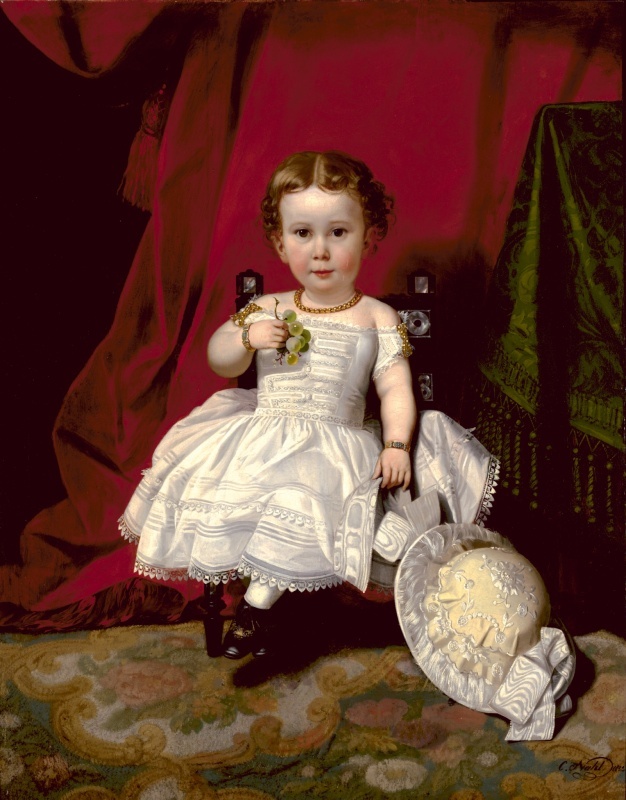
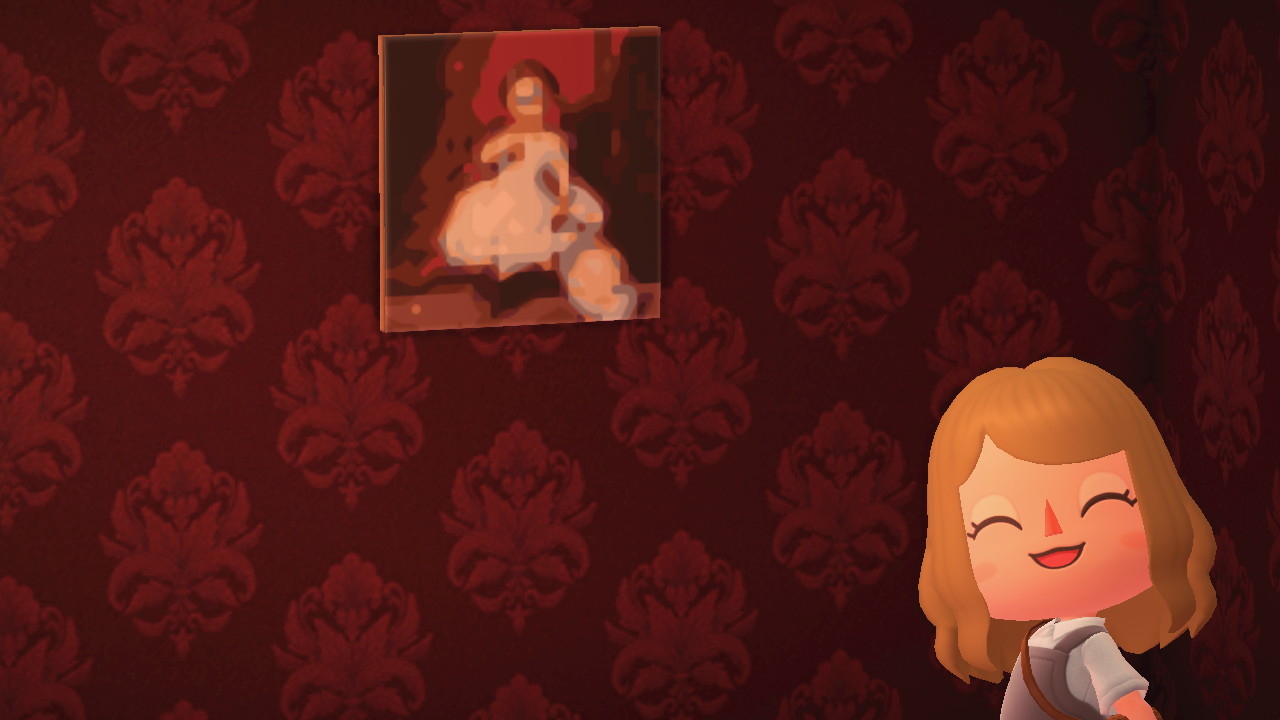
Charles Christian Nahl (American, born Germany, 1818–1878), Little Miss San Francisco, 1853. Oil on canvas, 38 x 30 in. Crocker Art Museum purchase, with funds from Mrs. T. Warren Kyddson in memory of her husband, Dr. T. Warren Kyddson; Mr. and Mrs. Vern C. Jones; Crocker Art Museum Memorial Funds; and others.
Screenshot: Nintendo (Sienna Stevens).
To the right of Mathews's mural is another work by Charles Christian Nahl. The Kassel-native showed early promise and received his earliest training from his father, an etcher, and engraver from a cousin known for painting portraits and historical scenes. Nahl also attended the academy in Kassel. Family turmoil motivated him to move to Paris in 1846, where he continued his studies with Horace Vernet and Paul Delaroche. There, he exhibited in the 1847 and 1848 Paris Salons.
In 1849, Nahl, his family, and their friend August Wenderoth sailed for New York and settled in Brooklyn. Lured by the prospect of gold, the group left for California in 1851. After failing to strike it rich, Nahl returned to art, first in Sacramento and then San Francisco. He excelled at portraiture, especially of children, like this early portrait entitled Little Miss San Francisco.
Carrillo and Crocker

[From left to right] Eduardo Carrillo (American, 1937–1997), Testament of the Holy Spirit, 1971. Oil on panel, 47 3/4 x 60 in. Crocker Art Museum purchase, with funds from the Maude T. Pook Acquisition Fund, 1972.24.
Stephen William Shaw (American, 1817–1900), Portrait of Judge E. B. Crocker, 1873. Oil on canvas. Crocker Art Museum, E. B. Crocker Collection, 1872.384.
Screenshot: Nintendo (Sienna Stevens).
Rounding everything off is a painting by Eduardo Carrillo (1937–1997) and a portrait of Edwin B. Crocker, one of the Museum’s founders. Carrillo’s art has been described as mystical, realistic, surreal, and visionary. A Chicano artist, teacher, and activist, Carrillo significantly advanced the recognition and appreciation of Chicano art and culture in California. His imagery, whether grounded in the mundane or infused with magical realism, reflects his relationship to his native California and to his Mexican heritage, his early religious upbringing, and European traditions in art.
As early as his graduate studies, it was apparent that Carrillo’s interests were narrative and allegorical, setting him apart from the Southern California Hard-Edge Painting, Pop Art, and L.A. Finish movements. In 1966, Carrillo moved to La Paz, Baja California, home of his grandparents, and established the Centro de Arte Regional, which he directed until 1969. His activist bent, however, faltered on his return to Los Angeles. The violence that marred the Chicanos against the Vietnam War demonstration in August 1970 disillusioned him, and he moved to Sacramento for a brief time. Testamento de el Espíritu Santo (Testament of the Holy Spirit) exemplifies Carrillo’s resulting turn to the visionary. The coiled snake — in reality, an ashtray — is a Pre-Columbian symbol of profound importance, signifying spiritual awakening (2).

Testamento de el Espíritu Santo, 1971.
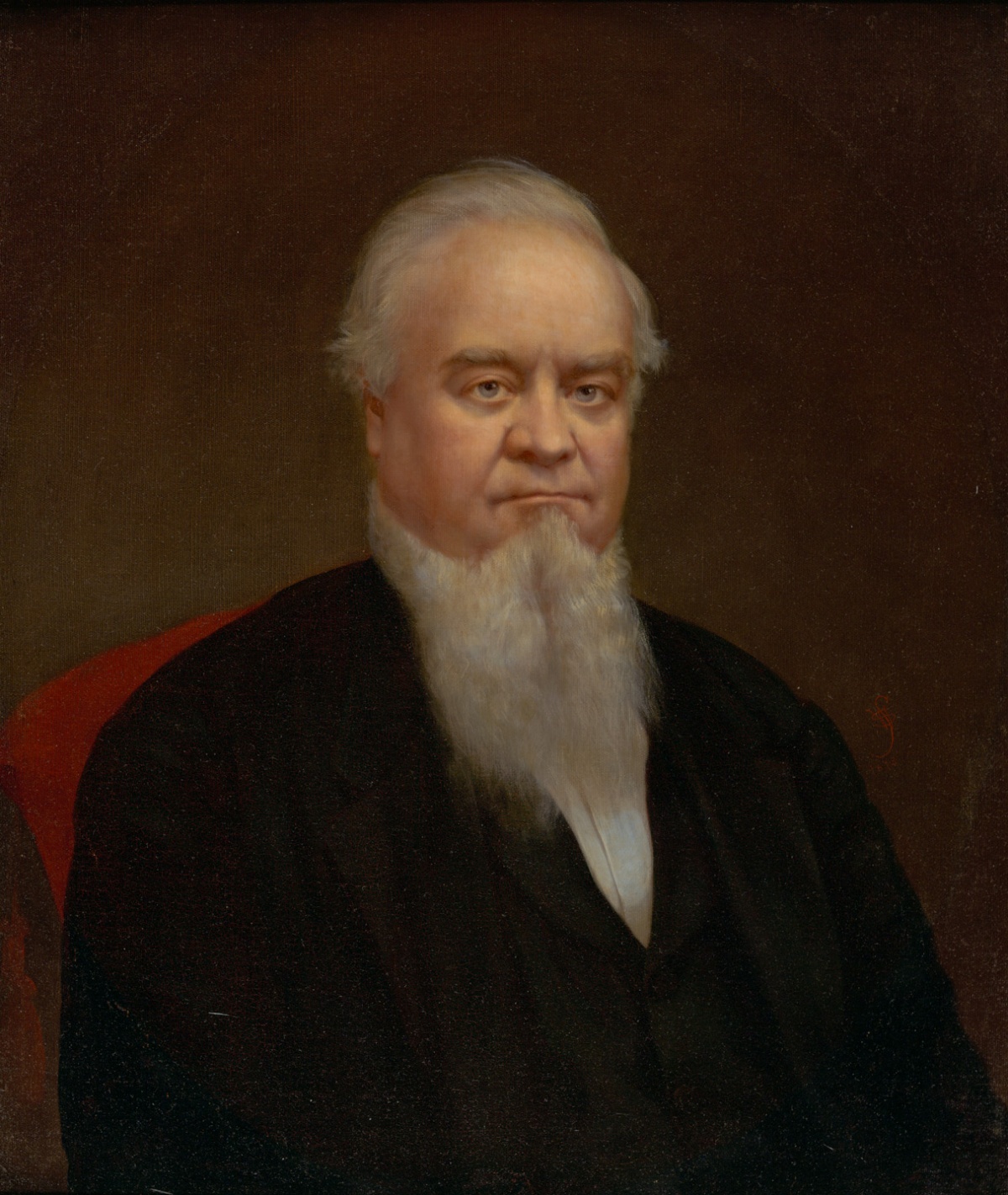
Portrait of Judge E. B. Crocker, 1873.
Last, but not least, is a portrait of the indomitable Edwin B. Crocker, one of the Museum’s founders. Edwin, or E. B., was born into a relatively humble New York merchant family and eventually moved to Indiana, where he became an attorney. There, he established an impressive practice and a reputation as a staunch abolitionist. In the 1840s his first wife passed away and E. B.’s grief — paired with the success of his younger brothers in California — prompted him to move to Sacramento in 1852, with his new wife, Margaret Eleanor Rhodes, in tow.
Once established in Sacramento, Edwin resumed his legal career. In 1854, he became the chair of the newly formed Republican Party, which was committed to promoting national unity, opposing the spread of slavery, and encouraging a transcontinental railroad. Party victory came with Lincoln's election as President and Stanford's election as California governor in 1861. Because of his expertise in common law and his prominence in party politics, E. B. was appointed a State Supreme Court Justice in 1863. During the seven months of his service, he handed down a record number of opinions.
In 1864, E. B. accepted an offer to serve as legal counsel for the Central Pacific Railroad Company, a company organized by Leland Stanford, Mark Hopkins, Collis P. Huntington, and Edwin's brother, Charles Crocker. Edwin — who had a famously zealous work ethic — was instrumental to the railroad's success. He managed corporate acquisitions, dealt with local governments, served as a principal adviser, and handled legal disputes. E. B. also supervised public relations and kept track of the railroad’s progress.
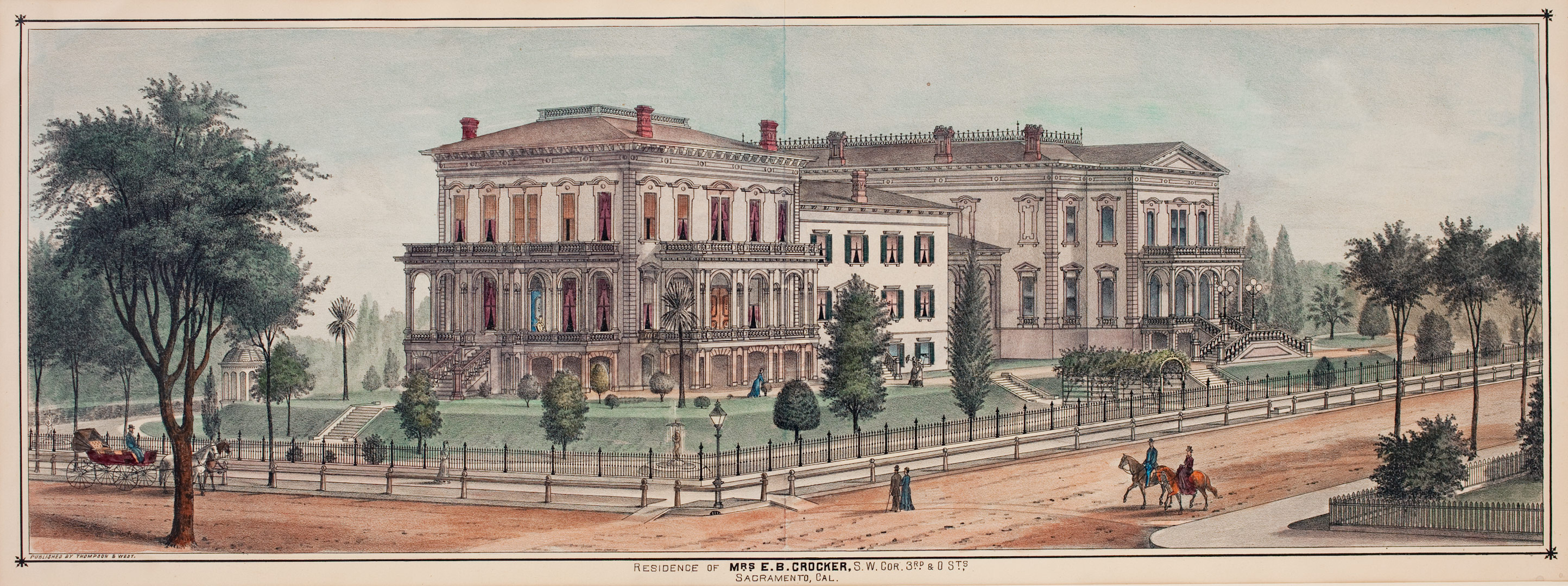
Thompson & West, Residence of Mrs. E. B. Crocker, S. W. Corner 3rd and O Streets, Sacramento, California, 1875. Hand-colored lithograph, 9 x 26 in. Crocker Art Museum, gift of the Art Service Group, 1976.17.
In June of 1869, Edwin suffered a stroke, leaving him partially paralyzed for the rest of his life. He retired from the railroad business and pursued other interests. These interests included renovation of the family's new home, commissioning an art gallery building, and embarking on a Grand Tour to Europe with his family from 1869 to 1871. The family moved into the new home in 1872, and the installation of the galleries was completed in late 1873. Unfortunately, Edwin was not able to enjoy his collection or magnificent gallery for long, as he died on June 24, 1875.
Today, Edwin’s contributions to the railroad and Sacramento have been largely forgotten. However, his legacy was carried on by his wife, Margaret, who, in 1885, gifted the Crocker Art Gallery and its collection to the city of Sacramento in a deed of trust, fulfilling her husband’s wish to establish a center of culture in California, which now houses all of the above works.
In Her Own Words
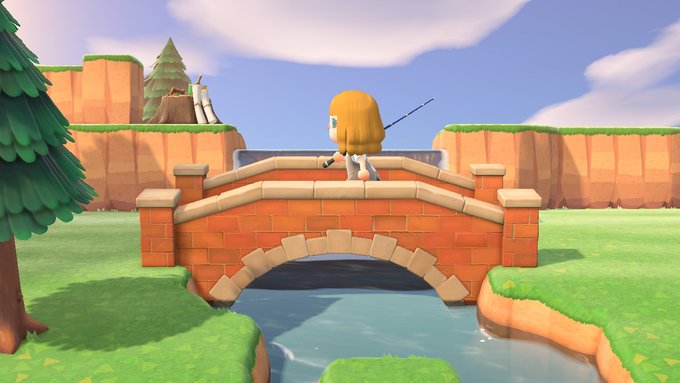
Screenshot: Nintendo (Sienna Stevens).
It seems most appropriate to close this post with a word from Sienna herself. She writes:
"I wanted to pick works of art from the Crocker that would be easily recognizable to everyone who has walked through the museum — even if you have only visited us once. Of course, we have many iconic works that didn't make it into my "Animal Crossing" museum, but I'd like to think that the handful I selected are some of our most memorable and striking.
Whenever I go up to the galleries on my breaks, I look forward to encountering the works I picked to recreate. I put great emphasis on trying to include works I have the pleasure of seeing every day in the Museum Store, as they adorn our Crocker magnets, postcards, journals, and more. I also felt it was only right to recreate E.B. Crocker's portrait in "Animal Crossing" to pay homage to our institution's roots."
We can't wait to see Sienna's picks in person again and we know many of you feel the same. So until then, stay safe and we'll see you soon.
Top Image: Redd, the dubious proprietor of Jolly Redd's Treasure Trawler. Screenshot: Nintendo (Sienna Stevens)
About the Author: Brian Hendershot serves as the Crocker's primary support editor, writer, and occasional audiovisual editor. Before joining the Crocker, he was the Head of Communications at the Museum of the Red River in Oklahoma. He also sat on the McCurtain County Historical Board of Directors and currently sits on the Crocker's MASS Action Committee. He received his MA in Communications at Drury University in Missouri.
About Sienna: Sienna Stevens has worked in the Museum Store for two years. She recently received her Bachelor's of Arts in Art History, with an emphasis on 15th to 18th-century art from California State University, Sacramento. Sienna has been playing Animal Crossing since she was eight, and has enjoyed perfecting her island, Eucalyptus, in New Horizons.
Works Cited: (1) Quoted in Gene Hailey, ed., Arthur Mathews, California Art Research Monographs 7 (San Francisco: Works Progress Administration, 1937): 17.
(2) Susan Landauer, The Not-So-Still-Life: A Century of California Painting and Sculpture. (Berkeley: UC Press, 2003), 138.



